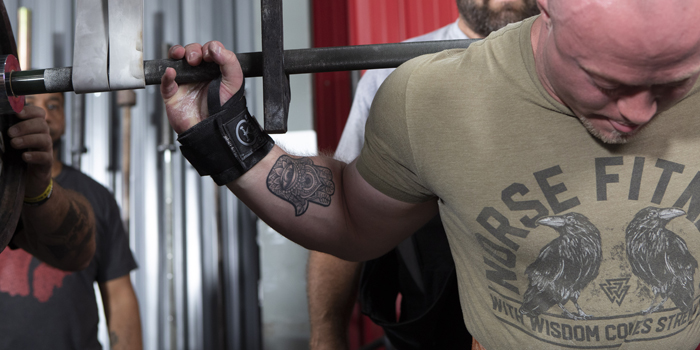
Oftentimes, your bigger players suffer from a lack of condition. These are the same players that need the size to execute their skill set yet are at the greatest risk of overuse-related injury if you try and run them into condition. Do you see the paradox?
In an attempt to improve these players' level of condition, I have programmed circuits, borrowing liberally from the work of Istvan Javorek, Chad Waterbury, Bud Jeffries, Christian Thibaudeau, and Dan John. I also recommend a wonderful book by Dr. J. Hartmann entitled Strength, Speed and Endurance for Athletes. It has wonderful diagrams of circuit activities.
In relation to these great writers and coaches, it is certainly a case of "If I have seen further, it is by standing on the shoulders of giants," notably said by Sir Issac Newton. I have popularized the Beastly Circuit as my go-to for this metabolic group of players, and many of my programs for the tight forwards of rugby will have this circuit as part of the training strategy.
The Concept of Endurance
I wanted to expand my ideas on this area of training, and as is often the case, I turn to the writing of Louie Simmons for his wisdom. In his book, Special Strength Development for All Sports, he discusses the concept of endurance. His definition for endurance is "the ability to counter fatigue," and this is exactly what we are trying to achieve with our bigger players so they can execute their skill set optimally for longer.
Louie discusses dynamic effort training utilizing a series of movements, which he equates to plays in an American football game, which I feel applies to rugby—a missing link in the training of our bigger players.
I call the program Pull-Push-Squat 3-2-1 Go since the reps used for each of the movements decrease from three to one. I do not claim any of this as my work, and I'm about to outline what Louie has recommended. The rest period between all sets is no more than 30–40 seconds, and every three weeks, some aspect of the program will change.
Pull-Push-Squat 3-2-1 Go
Box Squat
Wk1: 12 x 2 @ 50% bar weight
Wk2: 12 x 2 @ 55% bar weight
Wk3: 10 x 2 @ 60% bar weight
Then;
Deadlift
Wk1: 12 x 1 @ 50% bar weight
Wk2: 12 x 1 @ 55% bar weight
Wk3: 10 x 1 @ 60% bar weight
And finally;
Bench Press
Wk1: 9 x 3 @ 50% bar weight + 25% band tension at the top
Wk2: 9 x 3 @ 55% bar weight + 25% band tension at the top
Wk3: 9 x 3 @ 60% bar weight + 25% band tension at the top
On the three movements above, you can utilize the following:
- Straight bar weight
- Added chain weight
- Added band tension
- A combination of chain and band
- Use weight releasers
- Utilize the lightened (future) method with bands from the top assisting the movement out of the bottom position
You could also change the movement every three weeks but maintain the percentage each week as listed, for example:
Pull: Sumo Deadlift, Power Snatch, Power Clean
Push: Swiss Bar Bench Press, Push Press or Military Press, Incline Bench Press
Squat: Safety bar Box Squat, Front Squat to Box, Cambered Bar Box Squat
Keys to Avoiding Accommodation
When you complete this, I recommend a jump program of 50 reps in total utilizing an array of jumps, changing weekly to avoid accommodation, and using different jump heights and loading methods. Selecting from many jump variations is again the key to avoiding accommodation.
Change each week and try and set records each time to continually push performance improvements. Jumping with barbells, kettlebells/dumbbells, ankle/wrist weights, from different starting positions such as kneeling, sitting, standing, both in place and moving will ensure optimal development and transfer. In Louie's book Explosive Strength Development for Jumping (page 28), he outlines an excellent jump progression for all to follow.
Next in the program is some form General Physical Preparedness (GPP) training. Once again, you are limited by your level of innovativeness. Choose sled walking/dragging, weighted wheelbarrow walking, belt squat walking, or non-motorized treadmill work. These will all contribute to improved conditioning without running at all.
Finish the program with posterior chain exercises as part of the overall Core Accessory Rehab Exercise (CARE) program. Ideally, the Reverse Hyper® or Glute Ham Raise Bench, or similar, ensures you change these movements regularly and select the exercises that work best for each player.
Keep in mind the player's injury history profile and the specific injuries that are most common to the position they play. I have detailed these in many of my articles over the years, but an excellent reference point is this article by JHM Brooks and SPT Kemp, Injury-prevention priorities according to playing position in professional rugby union players.
Program one session a week like this year-round to add another dimension to your training as part of your overall strength and conditioning strategy.
Conclusion
In closing, below is a snapshot of how a session would look. Please remember that each session will change in some way, shape, or form to avoid accommodation. Depending on the training age of the players, you may have to change the details of the session from one to three weeks, every week for the more experienced, and less frequently for the beginner to novice players.
Pull-Push-Squat 3-2-1 Go
Movement Preparation (10 minutes)
Hip Mobility, Posterior Chain Activation, Ankle Mobilisation
Big Three Pendulum Wave Dynamic Effort (20 minutes)
Jump session (10 minutes)
Knees to Feet, Seated to Box
GPP session (10 minutes)
4 x 60 metres sled walk
CARE Program (10 minutes)
Hanging Leg Raises, Glute Ham, Calf Raises, Copenhagen Plank circuit 2 – 3 sets x 15+ reps
Training time equals 60 minutes. As you can see, there is no time to stand around and chat—you are on a mission. Please give it a go and let me know about your improvements on the field. After all, field performance is the best judge of program efficacy.
Ashley Jones has worked in three professional sports across 30 years and four continents. He was awarded the NSCA's Professional Coach of the Year in 2016. Ashley holds his CSCS (Certified Strength and Conditioning Specialist) since 1988.











It's a shame we're not closer. As one of my mentors I'm always 'all ears'. Plus the fact you give me the courtesy of debate/different window views.
:) Clive.
It has been so terrific reading all your articles over the years. I’ll still revisit them from time to time and I’ll always learn something new.
I have a question for you regarding training for 7s. I can train 4 or 5 days a week and have some decent strength levels however my fitness is not where it should be. Would you have any tips for a longer horizon? Say 3-4 months?
I’m currently thinking of doing something like your old program of 3 days a week. 2 days would start with a circuit, e.g. beastly variation or Otago circuit. Then weights would be:
M: lower body explosive (clean, snatch, trap bar jump, etc) + 3 push exercises (barbell, DB and BW/machine)
W: peak force, then 3x pull similar to above in selection
F: unilateral lower push & pull, then UB push and pull.
All days finished with CARE options.
Any programs you’ve found that would help with this would be highly appreciated. I’m slightly concerned this may not be enough volume but I would also want to be smart so as not to impact recovery.
Thanks Ash!
https://www.dropbox.com/search/personal?path=%2F&preview=id%3AGgkiKHqN1UAAAAAAAAAo9A&query=7%27s&search_session_id=36116228225527305141786469180919&search_token=WcrrtReBFDCKnlh9J60uTk3GRwHzCzaC8Ek%2BWuKoTxw%3D
I’m a long time reader of your work ever since your GetStrength days. I hope to begin getting my certifications in a few years. I am wondering if you would please be able to share Simon Price’s 7s program with me? The link you have attached above unfortunately does not like to the mentioned program.
If you would prefer not to share the link in public, would you please mind sharing it via email? My email address is zb8@gmx.com
Thanks for your response. Would you happen to have an alternative link? That link is not working.
Thank you,